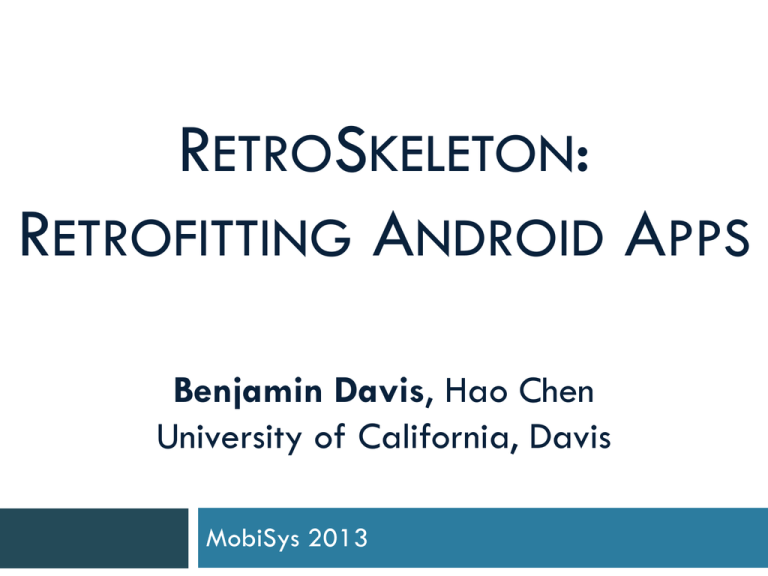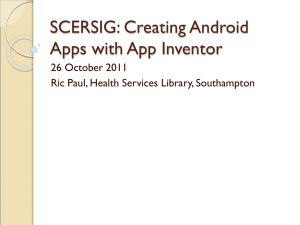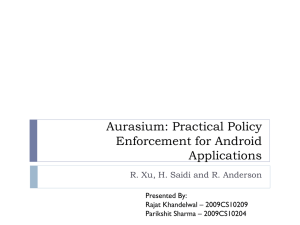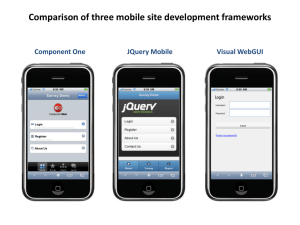RetroSkeleton: Retrofitting Android Apps
advertisement

RETROSKELETON:
RETROFITTING ANDROID APPS
Benjamin Davis, Hao Chen
University of California, Davis
MobiSys 2013
The
TM
Android
Platform
More than 600,000 third-party apps & games
on Google PlayTM alone
?
“What are these apps doing?”
“How can I control what these apps do?”
Android and Google Play are trademarks of Google Inc. The Android robot is reproduced or modified from work created and shared
2
by Google and used according to terms described in the Creative Commons 3.0 Attribution License.
Limitations of Android’s Permission
System
All or Nothing
Coarse-grained
No revocation
3
Current Proposals: Platform Modifications
Examples: TISSA (TRUST ‘11), Apex (ASIACCS ‘10)
Deployment Challenges
Proprietary binaries for device hardware
Requires rooting phone, voiding warranty, etc.
Inflexible
Difficult to enforce app-specific policies
New behavior requires system changes
Each Android version requires new implementation
4
Goals
Observe and control the behavior of third-party apps
Devices
Approach
Powerful
Complete
Policy
Require no platform modifications
App-independent
Applied automatically
Non-goal: prevent detection by app
5
Rewriting Android Apps
Observations:
Apps
interact with device via platform API method calls
95% of apps are implemented entirely in Dalvik
Dalvik bytecode is structured & unambiguous
Our approach: in-app method-call interception via
automatic bytecode rewriting
6
RetroSkeleton
Original App
Automatic
App Analysis
& Rewriting
Rewritten
App
REWRITING
OUTPUT7
Transformation
Policy
• Target Methods
• Method Handlers
INPUT
Intercepting Method Invocations
Interception strategy depends on:
Method
type (static, instance, …)
Method attributes (protected, final, …)
Invocation kind (direct, virtual, …)
Higher-level strategies for:
Inheritance
Virtual
method invocation
8
Inheritance-Based Interception
DatagramSocket
bind()
WedgeSocket
@Override
bind()
Android
Platform Code
App Code
DeveloperSocket
bind()
9
Challenge: Interception Completeness
Reflection API (behavior specified at runtime)
Statically
identify invocation of the reflection API
Add handlers to inspect and dispatch at runtime
Native and dynamically-loaded code
Detect
and intercept invocation
10
RetroSkeleton
Original App
Automatic
App Analysis
& Rewriting
Rewritten
App
REWRITING
OUTPUT11
Transformation
Policy
• Target Methods
• Method Handlers
INPUT
Transformation Policy Specification
Target Method
java.net.DatagramSocket
public void connect(SocketAddress peer)
throws SocketException
Handler Behavior
public static void retroSkeletonConnect
(DatagramSocket p0, SocketAddress p1)
throws SocketException
{
Log.i("RSKEL", "connect called!");
p0.connect(p1); // invoke target method
}
12
Use: Fine-Grained Network Access Control
evil.com
example.com
13
Use: HTTPS-Everywhere for Apps
HTTP
HTTPS
HTTPS Everywhere Project: https://www.eff.org/https-everywhere
http://
example.com
https://
example.com
14
Use: Automatic Localization
Good
Guten Tag!
Day!
setText("Guten
setText("Good Day!")
Tag!")
App Code
"GutenDay!"
"Good
Tag!"
translation
service
15
Evaluation
Run-time overhead: (0.2 µs) + handler
Rewrite speed: fast (~5 seconds)
Impact on app size: (0.5% for our policies)
Policy functionality:
Applied
to over 1,000 apps from Google Play
Tested rewritten apps in emulator & observed handler
behavior
Transformation Policy
Success
Network Access Control 99.5%
HTTPS-Everywhere
93.2%
Automatic Localization
99.6%
16
Conclusion
In-app method interception
App-agnostic policy specification and application
Automatic rewriting, no manual guidance
Rewritten apps deployable to any Android device
Coming Soon:
retroskeleton.com
17





















